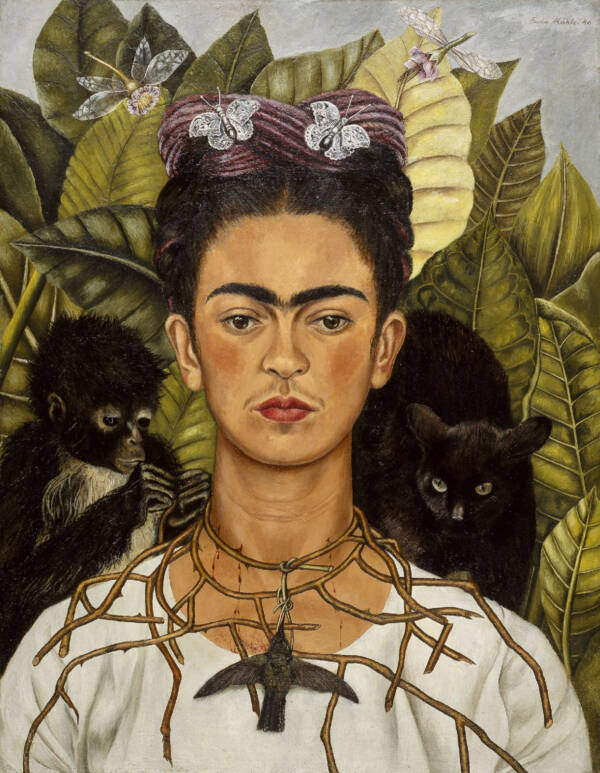The audio recording features Mexican painter Frida Kahlo as she recites an essay she wrote dedicated to her husband and creative partner, muralist Diego Rivera.

Archivists have discovered the only known voice recording of artist Frida Kahlo, revered for her distinct work and style.
More than six decades after her passing, Frida Kahlo is still one of the most recognizable painters today. Her paintings are revered by art-lovers around the world, while her face has become ubiquitous on everything from tote bags and t-shirts to coffee mugs and refrigerator magnets.
We know what she looked like, but what did she sound like? Nobody really knew until a recent discovery by the National Sound Library of Mexico. The institute has uncovered what is thought to be the only known audio recording of the famous painter.
According to the Guardian, the audio came from a collection of old tracks from a radio show called “El Bachiller” — named after its host Álvaro Gálvez y Fuentes who was also known as “The Bachelor” — and aired during the show’s premiere episode in 1955, the year after Kahlo’s death.
The library’s National Director Pável Granados said that Kahlo’s voice is one of the “most requested and sought-after” from the library.
“Frida’s voice has always been a great enigma, a never-ending search,” Granados told the press. “Until now, there had never been a recording of Frida Kahlo.”

Mexico Secretariat of Culture/TwitterFrida Kahlo’s voice recording displayed during the Mexican government’s announcement of the discovery.
The finding was announced by Mexico’s secretary of culture, which has a team of specialists still completing the verification of the recording to determine whether it is indeed Frida Kahlo’s voice.
But experts are confident that it is the voice of the famed artist.
A few clues hint to the recordings authenticity. First, the original label on the recording noted that the voice in the audio belongs to the artist who “no longer exists.” The recording is estimated to have been made in 1953 or 1954, around the same time that Frida Kahlo died.
But the biggest clue perhaps lies in the recording itself. In the two-minute clip, a woman can be heard speaking in a lively, robust tone:
“He is a gigantic, immense child, with a friendly face and a sad gaze,” the woman says in Spanish, continuing:
“His high, dark, extremely intelligent and big eyes rarely hold still. They almost come out of their sockets because of their swollen and protuberant eyelids – like a toad’s. They allow his gaze to take in a much wider visual field, as if they were built especially for a painter of large spaces and crowds.”
The words were taken from an essay the artist wrote herself, titled Portrait of Diego, that paints a picture through Kahlo’s own words of her husband, famous muralist Diego Rivera. It was part of a 1949 exhibition catalogue at the Palace of Fine Arts celebrating 50 years of Rivera’s work.
The complete segment that aired on El Bachiller featured voices from a number of other prominent personalities, such as the voices of painter-writer Dr. Atl and Lupe Marín, who was the wife of poet Jorge Cuesta.
The sound library has approximately 1,300 recordings from the show, which they will continue to digitize with the hopes of possibly finding more recordings of Frida Kahlo’s voice.
While Frida Kahlo’s persona has endured the test of time, there was never documentation of her voice, though photographer Gisèle Freund described Kahlo’s voice as “melodious and warm.”
During her lifetime, Frida Kahlo used her distinct style of painting to explore social issues in Mexico, such as post-colonialism, class, and race. But the subject that she consistently drew back to was herself.
Kahlo famously depicted her own reflection in numerous self-portraits that expressed her internal struggles as an Indigenous artist, a lover, and someone with a disability.

Libby Rosof/Flickr/The University of Texas at AustinSelf-Portrait with Thorn Necklace and Hummingbird, 1940.
She suffered from polio as a child, was in a bus accident when she was 18 that shattered several of her bones, and was diagnosed with spina bifida, a congenital condition that affects the development of the spine.
But her life story was just as fascinating as her art work, particularly her tumultuous relationship with her husband Rivera, whom she was unable to maintain a traditional domestic life with due to extramarital affairs on both sides.
Despite all this, the two remained infatuated and, in other ways, loyal to each other until the very end. That is why the newly discovered voice recording — a loving ode to Rivera — will resonate with the public just as her paintings have.
Now that you’ve caught up on the newly discovered voice recording of Frida Kahlo, listen to the earliest recording of JFK uncovered at Harvard 80 years later. Then, discover the Mannerheim recording, the only known audio recording of Adolf Hitler speaking privately.





